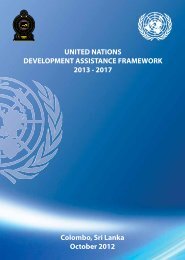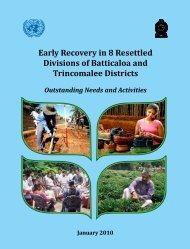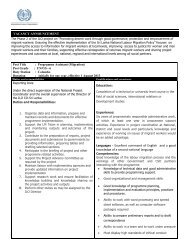Sri Lanka Human Development Report 2012.pdf
Sri Lanka Human Development Report 2012.pdf
Sri Lanka Human Development Report 2012.pdf
Create successful ePaper yourself
Turn your PDF publications into a flip-book with our unique Google optimized e-Paper software.
Technical Note<br />
Concepts, Definitions and Methodology for<br />
Computing the <strong>Human</strong> <strong>Development</strong> Indices<br />
<strong>Human</strong> <strong>Development</strong> Index<br />
The HDI is a summary measure of human development. It<br />
measures the average achievements in a country in three basic<br />
dimensions of human development: a long and healthy life;<br />
education, or access to knowledge; and a decent standard of<br />
living (Table T.1)<br />
mean years of adult education and 18 years of expected years<br />
of schooling for children of school-entrance age, respectively.<br />
These values are based on the actual values during 1980 to 2011.<br />
A decent standard of living is measured by GNI (gross national<br />
income) per capita expressed in PPP (purchasing power parity)<br />
US dollars. The minimum value is $100 (PPP); the maximum<br />
value is $107,721 (PPP). The logarithm of income is usually<br />
used in the calculation to reflect the diminishing importance of<br />
income.<br />
Table T.1: Dimensions of the <strong>Human</strong> <strong>Development</strong> Index<br />
Three dimensions Health Education (or access to knowledge) living<br />
standards<br />
Measured by Mean years of adult Expected years of Per capita<br />
life expectancy education, which is the schooling for children consumption<br />
at birth average number of of school-entrance expenditure<br />
years of education age, which is the total<br />
Four indicators received in a life-time number of years of<br />
by people aged 25<br />
years and older<br />
schooling a child of<br />
school-entrance age<br />
can expect to receive<br />
if prevailing patterns<br />
of age-specific<br />
enrolment rates stay<br />
the same throughout<br />
the child’s life<br />
The HDI sets a minimum and a maximum for each dimension,<br />
called ‘goalposts’, and then shows where each country stands<br />
in relation to these, expressed as a value between 0 and 1. The<br />
health component is calculated by using a minimum value<br />
of 20 years of life expectancy and a maximum value of 83.4<br />
years. These are the observed minimum and maximum values<br />
in the time series from 1980 to 2011. The minimums for both<br />
education indicators are 0, and the maximum values are 13.1<br />
For <strong>Sri</strong> <strong>Lanka</strong>, data on per capita GNI at district level are not<br />
available. Per capita consumption expenditure at district level is<br />
used as a proxy.<br />
The scores for the three HDI dimension indices are aggregated<br />
into a composite index using a geometric mean. Once the<br />
minimum and maximum values are defined, the sub-indices are<br />
calculated as follows:<br />
Dimension index =<br />
actual value for the country or districtminimum<br />
value)<br />
maximum value-minimum value<br />
sri lanka <strong>Human</strong> <strong>Development</strong> report 2012 167






